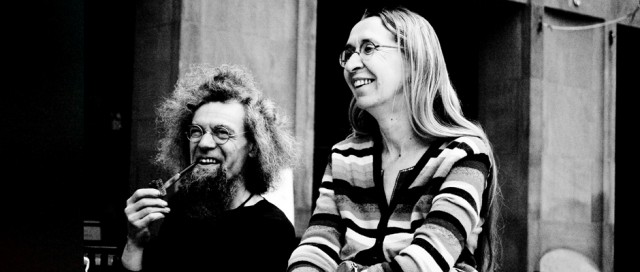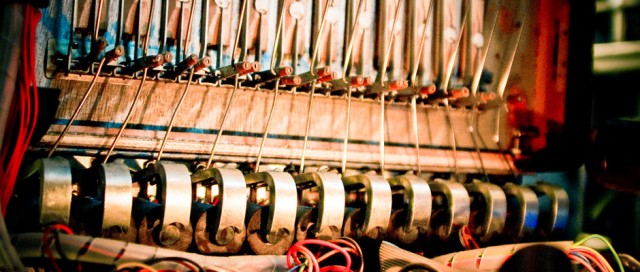Man & Machine: A Naked Robotic Love Story from Jesse Roesler on Vimeo.
Making music with machines, we all become somehow more than human. We are people, augmented by technology. Those technologies strip us bare, expose us as naked emotionally … sometimes, literally. Through the eyes of one filmmaker, here are two parallel images that drive that point home.
Last week at Berlin’s CTM Festival, we began a week-long hacklab by touring the Generation Z exhibition with curator Andrey Smirnov. One thing Andrey repeatedly emphasizes about the revolutionary Russian artists who came together in the 1920s is their belief in a future utopia, one constructed through technology to make a new breed of humans, humans merged with their machines. It was a tragedy that the Soviet state ultimately chose to repress the radical work of these artists.
But if their vision sounds like science fiction, if it sounds naive, that utopian fusion is something artists today are actually building. This is not some abstract vision of the cyborg: it’s people who have something to say, something deep to express, building tools that allow them to do so. That seems the fundamental need that drives all makers of music and musical instruments, whatever the technological medium.
Emmy-award winning filmmaker Jesse Roesler tells that story beautifully in his portraits of two artists.
On Sunday, we got to see his moving documentary of Godfried-Willem Raes and Moniek Darge, artists from Belgium. Raes, who was in attendance on Sunday, is an instrument builder and performing artist. His search for expression and his search for love intermingle.
Oh, and he has an unusual way of controlling his hand-built robotic symphonies. He strips buck naked and allows his bared body to control sounds through movement. The results are as weird and wonderful as they sound, but they also say a lot about the potential of body in tech and expression.
A talented young musician is expelled from the Ghent Conservatory in Belgium for being “musically ungifted.” The reason? His increasingly controversial experiments with “new music” which ultimately lead him to build an entire robotic orchestra—conducted by sonar radar bouncing off the naked skin of a human conductor’s body.
Godfried Willem-Raes began creating musical performances so forward-thinking that he made enemies of nearly all his Conservatory professors. His experimental approach to music-making left him creating controversial work on the fringe of modern music culture.
Shortly after being expelled, he met Moniek Darge, a performance artist who was creating similarly innovative and challenging work. The two joined forces and began a career of wild inventions including a singing bicycle symphony, an installation in which participants create music by rolling over human-sized pillows of air, and an ensemble performing radar-controlled, body-movement-mapped compositions.
Recently, they’ve completed building an entire orchestra of larger-than-life robotic instruments that are conducted by a naked human dancer using Doppler sonar radar waves. Their Man & Machine Orchestra is unlike any other musical ensemble in the world and generates a wave of controversial responses as they take it on tour in Latvia and other stops throughout Europe.
This documentary follows the trajectory of their rebellion, their collaboration and the challenges of maintaining a creative identity within a romantic relationship.
Will the epic culmination of Godfried and Moniek’s life’s work together find acceptance in modern music culture? Or must they follow the path of other composers, viewed as outcasts by their contemporaries but appreciated as geniuses by future generations?
http://manandmachinemovie.com/
Here’s what one of his performances looks like, here featuring another (naked, of course) dancer:
071018-09-sb-yoshiwara blues from Godfried-Willem Raes on Vimeo.
And you can find extensive materials on the robotic instruments and artist and friends alike at his official site, built on behalf of the Logos Foundation he founded:
http://www.logosfoundation.org/index-god.html
That search for expression is a real one, and it’s easy to take the marvels of our body/mind for granted. In “Music Is My Voice,” Roesler reminds us of the power of connecting humans to music, the necessity of crafting tools that make it possible.
Music Is My Voice from Jesse Roesler on Vimeo.
Dan Ellsey is a quadriplegic. With the visual tool Hyperscore, the creation of Todd Machover’s group of engineers at MIT Media Lab, gesture connects to visual notation. It’s an extraordinary means of expression, and again can draw a direct lineage to the optical music and gestural ideas of early Russian techno-revolutionaries.
This is an old TED talk, but one worth re-watching.
And here’s a demo from 2006. It’s perhaps doubly worth revisiting this as it seems long overdue for other software building on this idea.

